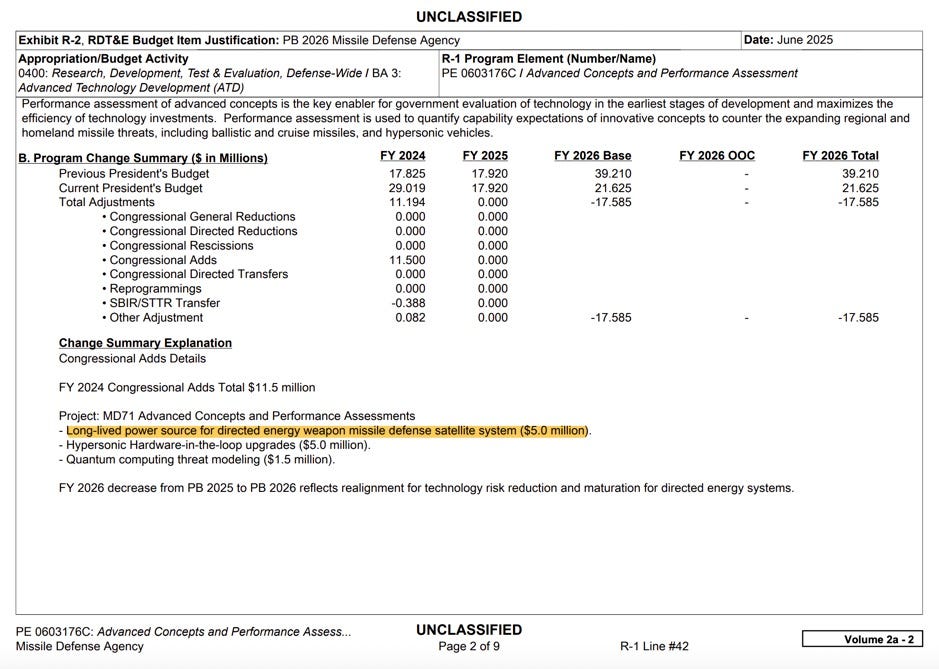The Return of ‘Star Wars': The Pentagon Is Eyeing Space Lasers for Missile Defense
The American dream of an orbital directed energy weapons is alive and well.

The US Defense Department may be reviving one of its most ambitious ideas ever, Laser Wars has learned: orbital laser weapons for missile defense.
The Missile Defense Agency’s fiscal year 2026 budget request for research, development, testing and evaluation outlines broad plans to engage with the US defense industrial base and national laboratories to explore the “effectiveness and capability” of various directed energy weapons for missile defense, efforts the agency has pursued on and off for decades.
But buried in the budget book is an unusual item: $5 million to explore the development of a “long-lived” power source for a “directed energy weapon missile defense satellite system.”

Presented as a fiscal year 2024 congressional addition, few details are publicly available regarding the initiative other than that it appears to be in the very early stages.
The mention pops up under the MDA’s $21.6 million request for its Advanced Concepts and Performance Assessments program (Project MD71), which is described as “the key enabler for government evaluation of technology in the earliest stages of development and maximizes the efficiency of technology investments.”
”Performance assessment is used to quantify capability expectations of innovative concepts to counter the expanding regional and homeland missile threats, including ballistic and cruise missiles, and hypersonic vehicles,” the budget documents say. In short, the program serves as an incubator — a sandbox for high-risk, high-reward ideas that might shape the future of missile defense before they’re ready for prime time.
While previous budget requests stretching back at least five years have contained funding under the MD71 project code to examine “pathfinder” solutions to demonstrate the utility of directed energy weapons for missile defense, this year’s line item is the first explicit mention of a space-based platform to show up in MDA’s budget documents since 2019, when the agency requested $34 million in fiscal year 2020 R&D funding to “design, develop, and conduct a feasibility demonstration for a Space-Based Directed Energy intercept layer” involving a notional particle beam weapon1 amid a renewed look at orbital solutions.
It’s unclear if this year’s line item is tied to President Donald Trump’s “Golden Dome for America” missile defense initiative, which Laser Wars recently reported includes $51 million in funding to develop a new ground-based Joint Laser Weapon System (JLWS) to intercept cruise missiles.
The MDA did not respond to a request for additional information from Laser Wars.
While $5 million may seem paltry in the context of the MDA’s total $10.5 billion R&D budget request, the item suggests that the Pentagon is casting a wide net regarding novel capabilities to bolster homeland missile defenses — one that apparently includes a return to the fantastic vision of space-based directed energy weapons that President Ronald Reagan first pursued more than four decades ago.
In a March 1983 address to the nation, Reagan had proposed replacing the US government’s Cold War doctrine of mutually assured destruction by nuclear holocaust with a network of futuristic weapons capable of intercepting incoming ballistic missiles before they reached American soil. Officially dubbed the Strategic Defense Initiative (SDI), the undertaking was derisively nicknamed “Star Wars” by Sen. Ted Kennedy in an interview with the Washington Post the day after Reagan’s address.

Under the SDI, the Pentagon pursued several ambitious space-based directed energy weapon concepts. According to a 1993 Government Accountability Office (GAO) report, the department spent almost $4.9 billion over nearly a decade on research into orbital high-powered chemical laser platforms; neutral particle beam weapons like those included in MDA’s fiscal year 2020 budget request; a so-called “x-ray laser” known as Project Excalibur that relied on nuclear explosions for power generation; and, most uniquely, a system that proposed using a network of space-based relay mirrors to reflect ground-based free-electron lasers onto targets in the atmosphere. This funding also supported the development of target acquisition, tracking, and pointing subsystems across multiple SDI directed energy activities.
But by the late 1980s, SDI had stalled. Technological breakthroughs never materialized, costs ballooned, and the collapse of the Soviet Union rendered the project strategically irrelevant. After more than $30 billion spent on the program, President Bill Clinton finally canceled it in 1993 without the system ever deploying. Despite the Pentagon’s claim to the GAO that several of SDI’s space-based directed energy weapons were just four years away from reaching a technological readiness level where system-level demonstrations were feasible, the department conceded that it had “not prepared a new detailed plan for carrying out its responsibilities for development of directed energy technologies and does not plan to do so,” marking an effective end to the US military’s Cold War directed energy ambitions.

Despite this, the concept of an impenetrable missile shield has persisted. Indeed, Trump’s January executive order kicking off the Golden Dome effort explicitly cited the SDI program as an inspiration for his new missile defense push.
Reagan “endeavored to build an effective defense against nuclear attacks, and while this program resulted in many technological advances, it was canceled before its goal could be realized,” Trump said. ”Over the past 40 years, rather than lessening, the threat from next-generation strategic weapons has become more intense and complex with the development by peer and near-peer adversaries of next-generation delivery systems and their own homeland integrated air and missile defense capabilities.”
The enduring allure of space lasers is understandable, especially amid the Pentagon’s renewed focus on establishing space superiority over near-peer adversaries, as the US Space Force’s top officer detailed in March.2 Constellations of space-based directed energy systems could potentially provide near-instantaneous coverage of the entire planet, a rapid response to fast-moving threats like ballistic missiles without the potential constraints of magazine depth. Even with the potential factors like atmospheric interference, the vacuum of space is an ideal medium for propagating a laser beam across great distances. US military laser weapons have matured rapidly in recent years, despite some stumbles — perhaps the technology is finally ready for another trip to the stars.
But major challenges remain. Despite its appeal, a space-based laser constellation would require a staggering investment in launch, tracking, targeting, and sustainment infrastructure. These complex, power-hungry satellites could also become high-value targets, vulnerable to kinetic and electronic countermeasures from adversaries. Any future system must also survive the hostile physics of orbital warfare, including space debris, jamming, and emerging enemy anti-satellite capabilities.
Based on the budget documents, it appears that power generation in particular is top of mind to US military planners. Indeed, the MDA’s budget line item explicitly focuses the agency’s research on long-lived power sources, which are generally understood as those that operate continuously for extended periods without refueling, recharging, or replacement, like radioisotope thermoelectric generators and advanced photovoltaics.
High-energy lasers require significant amounts of electrical energy to achieve lethal power levels, and generating and storing sufficient energy in orbit is a major technical barrier. Solar is the most logical option, but it’s unclear if current technologies are sufficient enough to generate the power needed for effective operations. Meanwhile, nuclear sources come with their own geopolitical baggage, not to mention grave safety concerns. In contrast, long-lived power sources are ideal in scenarios where resupply is difficult or impossible and mission endurance is critical (see: outer space), capable of potentially providing a reliable and stable high-output energy source that could sustain repeat laser firings over many years in orbit.

But long-lived power sources aren’t a silver bullet. Their continuous heat generation poses problems for thermal management, which is increasingly important to prevent material degradation of the host platform when the heat of the laser array meets the cold, hard darkness of space. With no atmosphere to conduct or convect heat away, a notional laser satellite would require robust radiators and cooling systems to maintain the platform as a durable orbital asset. Designing those thermal control systems to function reliably over years in outer space, let alone meet tight size, weight, and power constraints, may prove just as difficult as generating the power in the first place.
Despite decades of setbacks, the appeal of space-based directed energy weapons persists because they offer something few other systems can: global reach. Ground- and sea-based interceptors remain limited by geography and response time, while space-based lasers (at least in theory) offer constant overhead coverage and immediate engagement potential, especially in the opening moments of a missile launch. That constant presence — always watching, always ready — is precisely what makes them so seductive to missile defense planners, and so unnerving to adversaries
Any renewed push for orbital directed energy weapons will likely provoke concern in Beijing and Moscow, where officials have long warned that U.S. plans to deploy space-based missile defenses, including Trump’s Golden Dome initiative, could destabilize the geopolitical status quo. A public pursuit of such systems would almost certainly complicate arms control talks and risk triggering a new wave of anti-satellite weapons development — not just from adversaries, but from wary allies.
Whether this $5 million MDA line item eventually blossoms into a viable system or ends up simply another footnote in the long history of space laser dreams remains to be seen. But it signals a clear reality: the age of orbital deterrence is no longer just the stuff of science fiction. As missile threats evolve and geopolitical competition extends into orbit, the Pentagon appears willing to reimagine “Star Wars” for the 21st century. After all, nothing says “peace through strength” quite like a high-powered laser silently circling the Earth, waiting for its moment to strike.
A neutral particle beam is a type of directed energy weapon that accelerates a stream of uncharged particles like neutrons to very high speeds to damage or destroy a target. For more on its potential applications to strategic defense, read this 1989 report from the Los Alamos National Laboratory.
As a Jewish man and Los Angeles resident, I would be remiss if I didn’t note the connection between the US Space Force’s “non-kinetic” ambitions and Rep. Marjorie Taylor Greene’s claim that Jewish space lasers were responsible for the devastating 2018 California wildfires. The Space Force is technically a department of the US Air Force and, as any good student of Lenny Bruce knows, the Air Force is the Jewish branch of the US military (despite evidence suggesting otherwise). Anyway, you should read Jewish Space Lasers: The Rothschilds and 200 Years of Conspiracy Theories — it’s not exactly a directed energy book, but it’s just as illuminating.







Fascinating. Appreciate the historical context